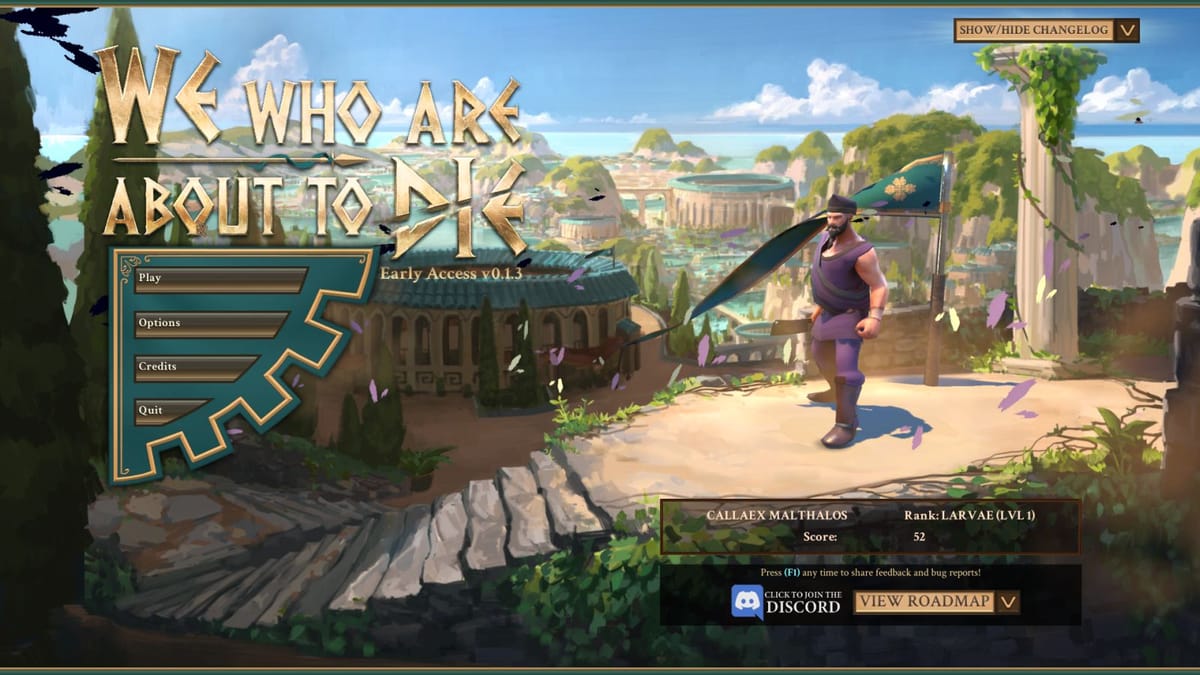
It seems that the gaming market is flooded with rogue-lites that offer initial difficulty, but rapidly taper off in challenge as the vertical progression kicks in. We Who Are About To Die is not one of those rogue-lites. It’s difficult, and it remains difficult until you learn the mechanics.
We Who Are About To Die (or WWAATD) is a third-person rogue-lite where you fight to the death in gladiatorial combat. At its core, it’s about achieving balance in your choices, as all of your actions and inactions have consequences. Right off the bat, you’re warned by a loading screen. This is not an easy game. You WILL die, and that’s okay. The point of this game is to die, fight, and die again until your skills are as sharp as the weapons you fight with.
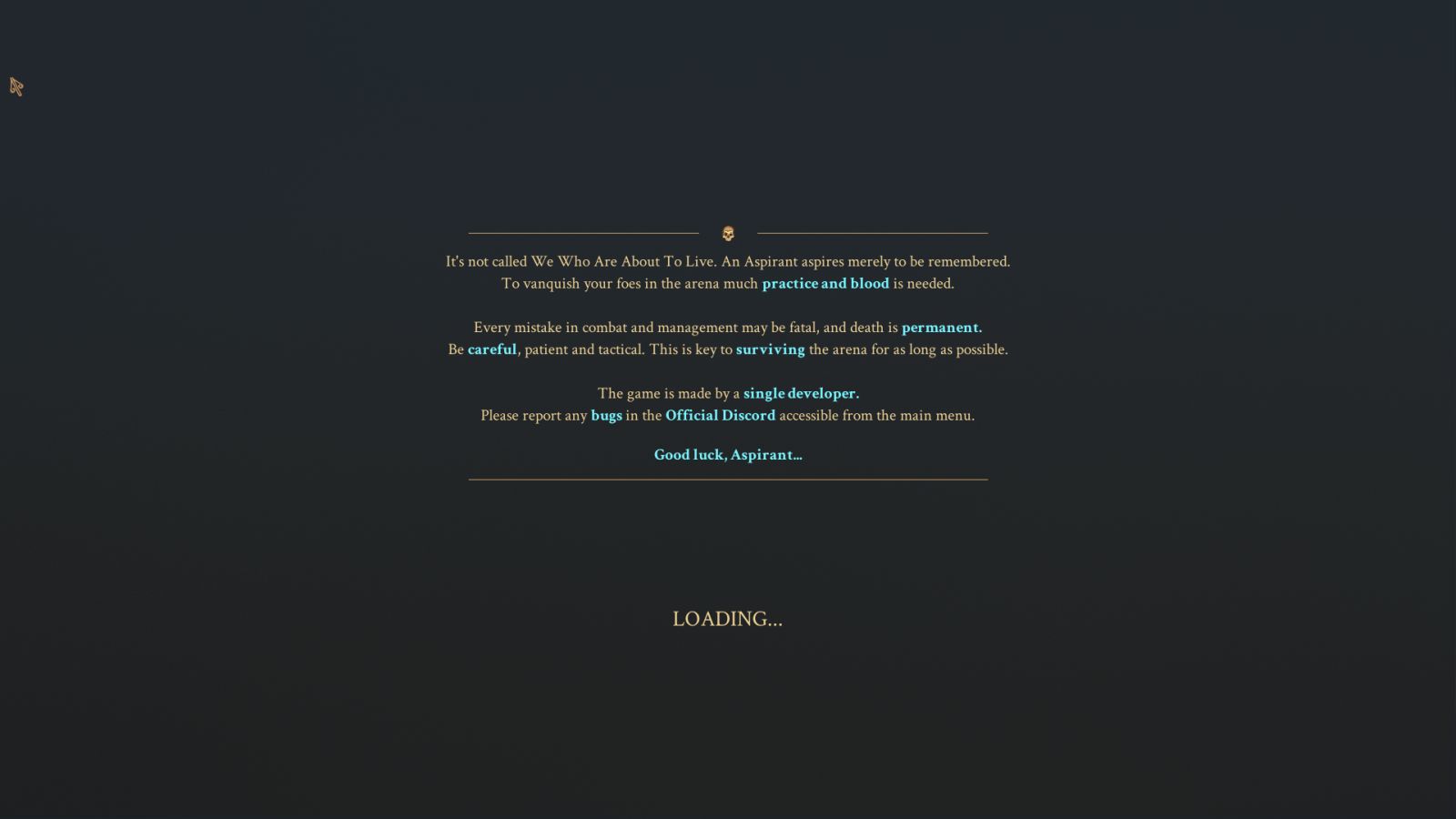
The blue/green and gold aesthetic is solid, but alerting the player to the fact that the whole game was made by one developer made me warry. It felt like hedging. When two of the handful of key highlighted words are: “single developer” and “bugs” it tends to send a message, especially when the game is still in early access. However, I can positively say that the bugs I encountered were minimal. The worst I encountered was a single crash and some shoddy third-person camera work.
Hopping into the main menu cues the triumphant music, I hadn’t even played yet and I felt like I’d won. We get a first glimpse of the art style, a combination of toy-like 3D models and stunningly vibrant 2D artwork. The gorgeous vista behind my purple pit fighter is one I would love to spend time fighting in. Once more I would like to state that this game was made by only one man, Jordy Lakiere. He did everything with the exception of the music, sound effects, and web development. His effort did not go to waste, as WWAATD has great presentation. The audio is great at building anticipation. From the drumming heartbeat before you enter the arena, to the slow scraping stone noise when an item is about to be revealed in the shop, this game knows how to put on a show.
If you play games for riveting stories, then WWAATD may not be for you. The story is almost nonexistent, and that’s okay. The focus is on the gameplay. The worldbuilding that is there is almost entirely through loading screens and sometimes general events. It’s not completely absent, and it definitely has the potential for expansion, but as of now, it’s a minor aspect mostly meant to add a little flavor to the various types of gladiators.
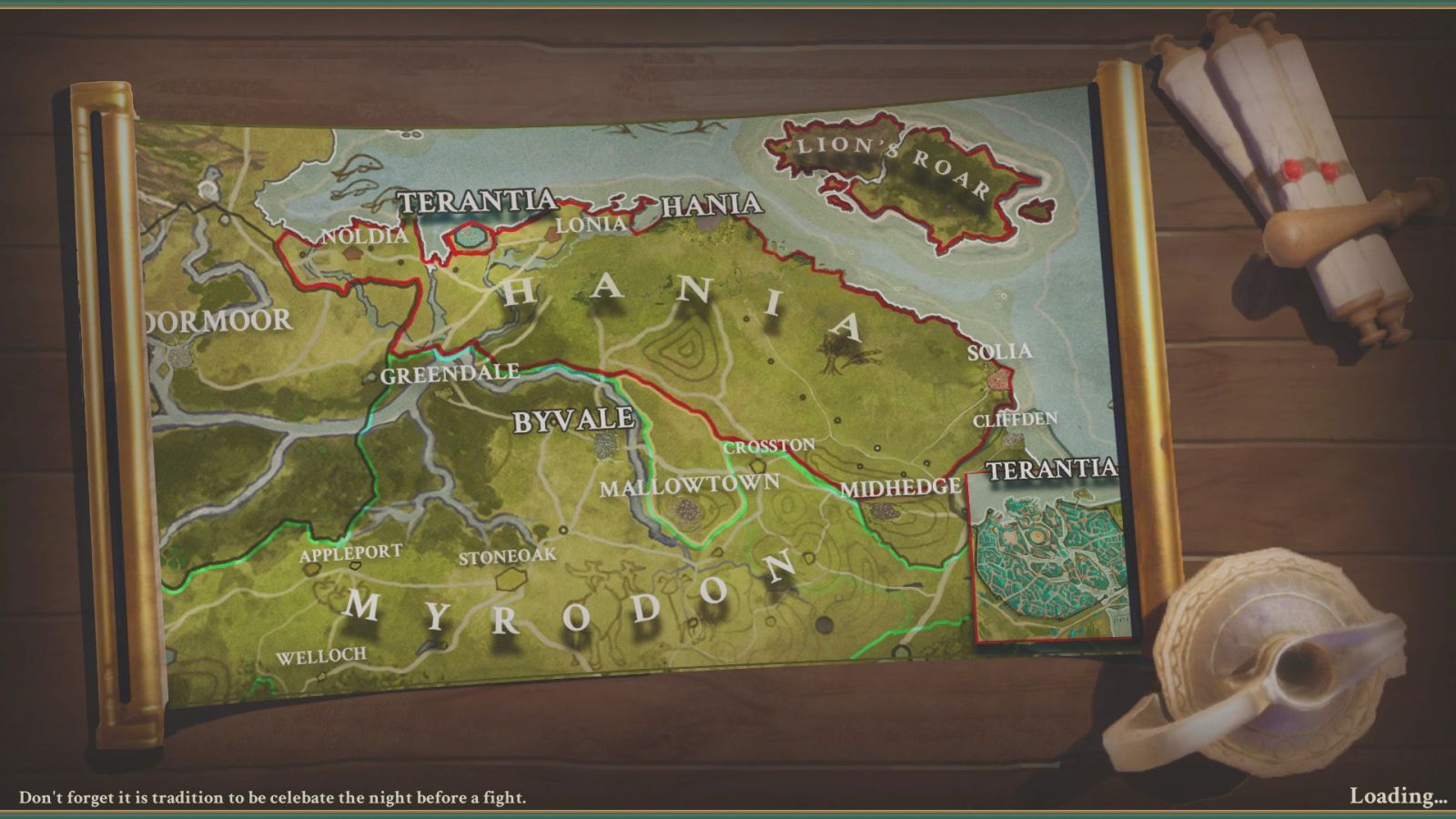
WWAATD is a rogue-lite, so every run grants you a new gladiator. They all belong to the Scollo, a gladiator guild from where all of your fighters originate. They have one of five backgrounds: The Professional Aspirant is a seasoned gladiator. They know their way around the arena, but its harder for them to get their name out there. There’s also The Former Soldier. They’re tough, but their stamina is lacking. If you want to play a less honorable gladiator, you could go with The Criminal Scum. They’re skeevy and great at bribing and betting, but no one is in your corner. Then things get more difficult and complex with The Slave. The more you win, the more people admire you. Everyone loves a good underdog, but you lose out on gold income because half of it goes to your Scollo. Finally, we have The Thrill Seeking Civilian. Just as his name suggests, he plays like the thrill junkie he is and gets better stamina regeneration the lower his health is. He also doesn’t really have to be there, so he gets cheaper match skips, but the Scollo takes some of the money he earns. These are all of the gladiators currently in the game, but the roadmap states that the end goal is for there to be 10+ backstories.
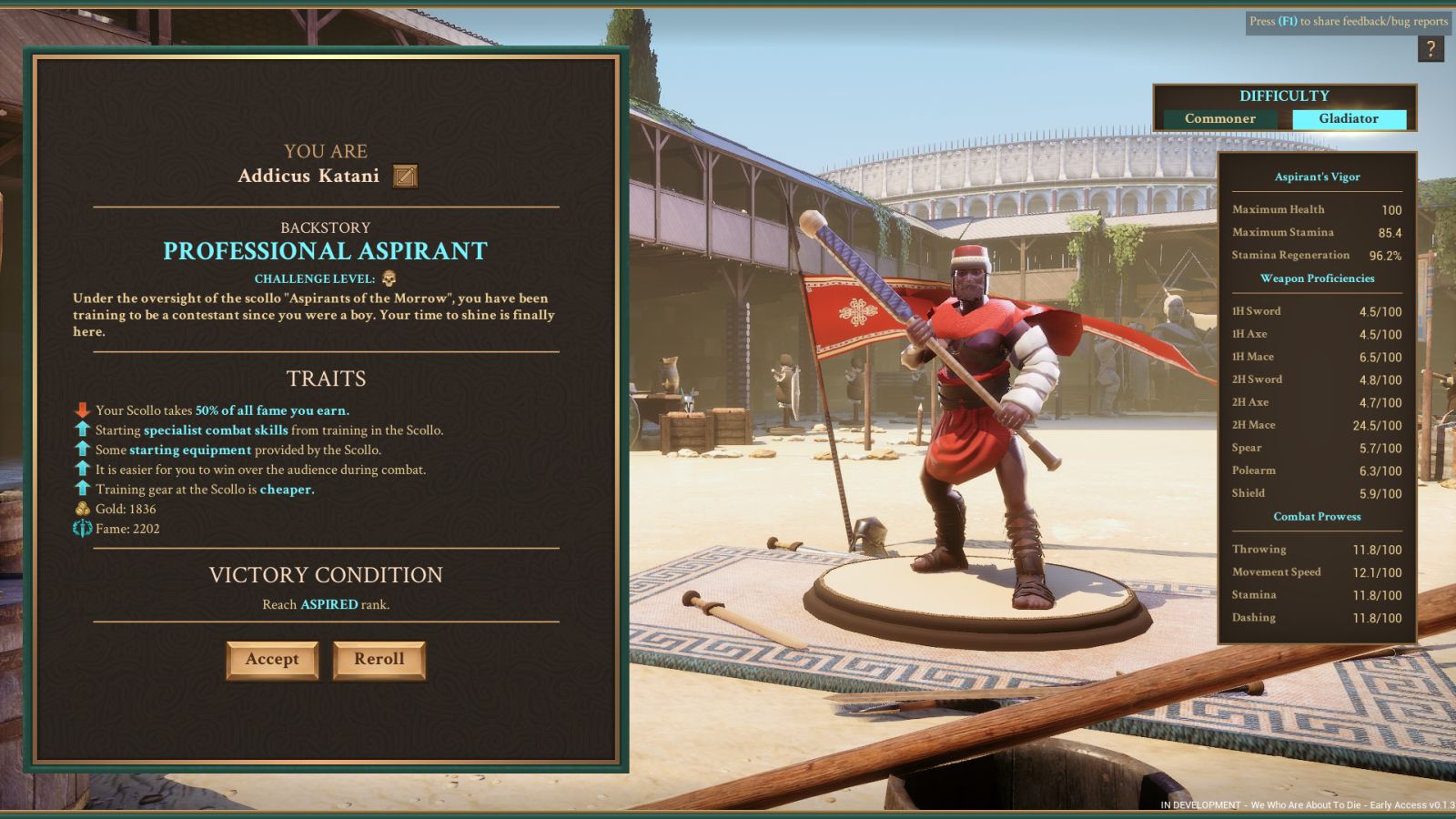
Each gladiator has their own victory condition and difficulty level. Upon beating the game you gain a Legacy Reward depending on which gladiator you won with. This is one of the few instances of meta-progression in the game despite its rogue-lite tag on Steam. I would recommend beginners to start out with the professional Aspirant or Former Soldier. Their stats are good and their win conditions are straightforward.
What if you don’t like the gladiator type you rolled? Well, there’s a reroll system. The system is flawed in that you can reroll as many times as you want. The only drawback is you lose out on possible heirlooms from the previous gladiator you won with, which is a small price to pay for unlimited rerolls. Just keep going until you roll a character with a 20 in a stat then min max to your heart’s content. It’s out of place in a game where your actions usually have dire consequences.
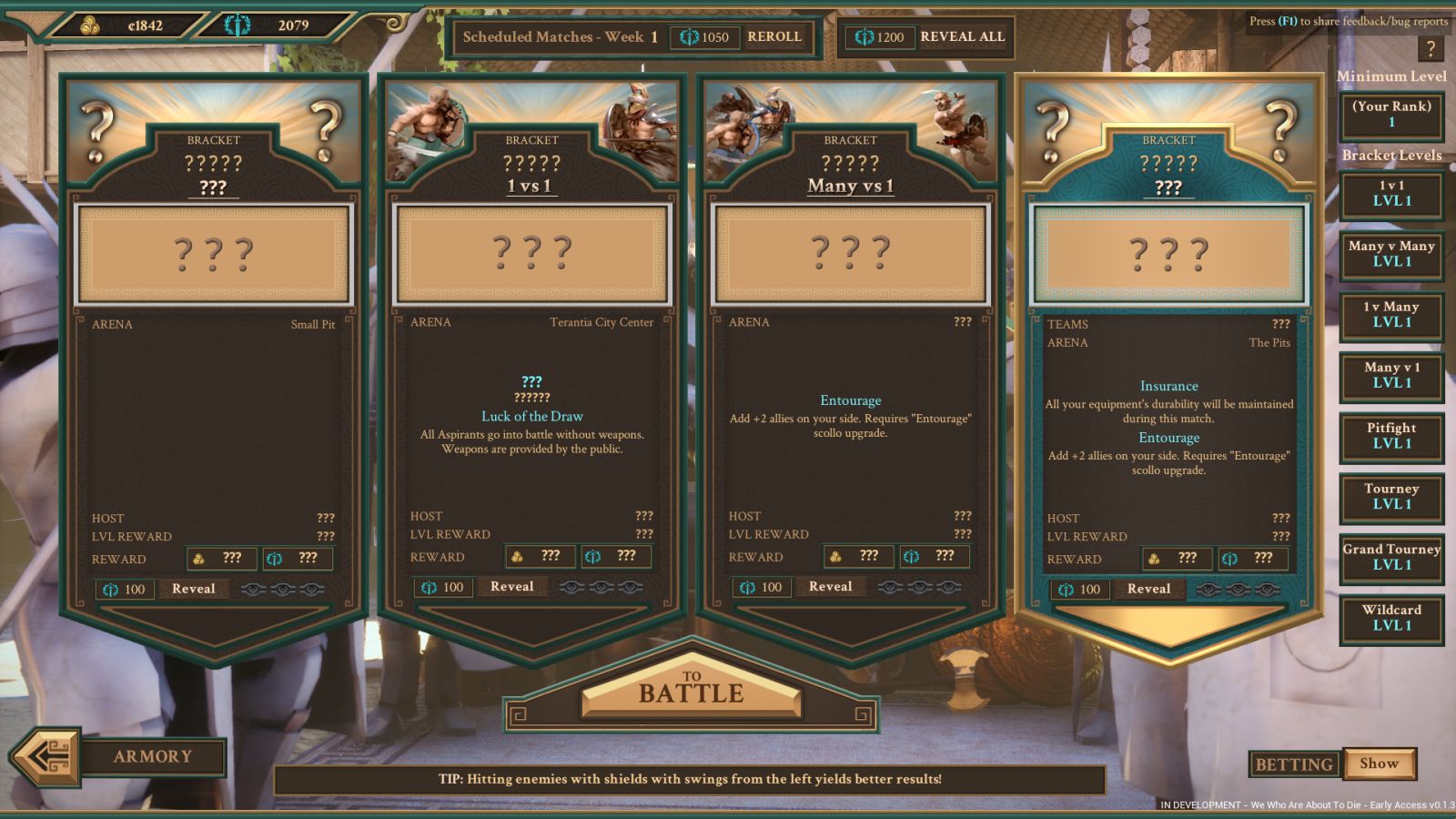
While you’re not in combat, you will be spending your time in the utility, armory, and battle menus. You can upgrade, heal, and view your gladiator’s progress in the utility tab. You can buy, sell, store, and equip weapons and armor in the armory tab. Then when you’re ready to fight, you can head over to the battle tab to view your potential matches. Winning a match gives you two currencies, gold and fame. They can be used in the previously mentioned tabs to buy various upgrades. Fame can also be used in the battle tab to reveal more information about the fight. What’s the bracket? Who will I be fighting? How many of them are there? Will my perks be relevant? Having this knowledge is crucial to secure a clean victory. Sure, you could enter a match completely blind, but then you could be walking into a 1vX situation. You could reveal just some information, so you know what the bracket is. However, you’ll probably want to know if you’re about to enter the arena with three pit slaves on your side against four seasoned gladiators. This information is especially important for the early rounds where you’re most vulnerable with little armor and wooden weapons.
The importance of having game knowledge compounds when you account for the fact that Health persists between matches. You’re only given a tiny portion of health back from resting after matches, and doctors’ visits increase in cost and decrease in effectiveness the more you use them. Every hit you take can have a long-lasting impact. Another major aspect of the battle tab is betting. Essentially, optional objectives that grant you bonus gold. The only downside is you have to front a hefty sum of cash for bets. All of these systems tie into one another and the decisions you will have to make, all before the fight even begins.
Each fight is attributed to one of four patrons, Alluora, Valerius, Mazza, and Joridus. Favor them and they’ll favor you. Fight in matches with their names attached and you’ll gain their favor, ignore them and they’ll make your life more difficult. Having a patron like you means that there’s a good chance an event will trigger giving you some buffs and upgrades. These however, are not freebies. For example, Mazza might offer to build you a statue, increasing your fame, but you have to pay her a hefty sum of gold to do it. If they don’t like you, then they might throw full festivals to decrease attendance at the arenas, thus decreasing earned fame, just to spite you. There’s no end to their Machiavellian plotting, so try to stay on their good sides. This adds another layer to the risk-reward. Sure, one match may offer free weapons and armor that you can keep, but you may be spiting a patron who you have already snubbed time and time again.
While there are patron events, there are also general events. Your sword may break and need urgent repairs, or stories of your gladiator spread, thus increasing your fame. These events can be completely random and unfair, and I love it. Life in the fighting pits is brutal, you have to adapt to your circumstances and make sacrifices. Be prepared to make some tough calls.
 The combat is physics and directional-based, so rather than just clicking the mouse to attack you have to click and drag in a cardinal direction to guide your blows. On top of that, you have jabs and overhead attacks. When in doubt, overhead attack. It’s effective against almost every enemy. All attacks and dodges drain stamina, so you have to carefully manage it while you level it up. Damage is tied to your weapon’s momentum, so you’re capable of doing some pretty gnarly moves that are as effective as they are fun to pull off. Sprinting and lunging in your enemy’s direction can help add some damage to a first blow before you back off into a more defensive stance. Sometimes, when you kill an enemy, their bodies will rocket into high orbit. This is most likely a bug, but it’s hilarious to watch it happen. There’s also optional gore, which I always love to see in medieval slashers. It feels satisfying to master the gameplay, gracefully moving around the arena bisecting enemies. Speaking of the arenas, there’s a wide variety of fighting venues. From street fights, to villa brawls, to clashes in the arena, the large range of possible battle stages keeps the game feeling fresh.
The combat is physics and directional-based, so rather than just clicking the mouse to attack you have to click and drag in a cardinal direction to guide your blows. On top of that, you have jabs and overhead attacks. When in doubt, overhead attack. It’s effective against almost every enemy. All attacks and dodges drain stamina, so you have to carefully manage it while you level it up. Damage is tied to your weapon’s momentum, so you’re capable of doing some pretty gnarly moves that are as effective as they are fun to pull off. Sprinting and lunging in your enemy’s direction can help add some damage to a first blow before you back off into a more defensive stance. Sometimes, when you kill an enemy, their bodies will rocket into high orbit. This is most likely a bug, but it’s hilarious to watch it happen. There’s also optional gore, which I always love to see in medieval slashers. It feels satisfying to master the gameplay, gracefully moving around the arena bisecting enemies. Speaking of the arenas, there’s a wide variety of fighting venues. From street fights, to villa brawls, to clashes in the arena, the large range of possible battle stages keeps the game feeling fresh.
The moment-to-moment gameplay can occasionally be tedious, especially in some nondual brackets. For example, ending a many v many match often devolves into your team huddling around the last enemy, trying to cut them down. They usually end up hitting each other, and more importantly, you. Another problem with many v many matches is that occasionally, your team can be in white armor with some black, and the enemy can be in black armor with some white. It doesn’t happen too frequently, but I have beheaded a teammate because of it.
On another note the Camera that tracks your gladiator can be awful, I have almost lost a handful of gladiators from the camera blocking my view of the combat. Getting a solid quarter of your health hacked away because the camera decided to clip through a wall is never fun. It doesn’t feel unfair in the brutal gladiatorial sense, it feels unfair in an unpolished sense.
Another aspect of combat is precision. If you don’t get good at landing headshots, then it can feel like you’re fighting with a wet noodle. It can take upwards of 30 hits on one starting enemy just to take him down if you’re using a starter weapon and not getting headshots. The number of hits to kill drops significantly to about four (assuming they don’t have a helmet) when you obtain a good weapon and land all headshots from proper distance. Keep your distance and know your weapon’s effective range, and you can cut them down like a warm knife through peasant.
There is one notorious enemy type. The spear and shield user. This enemy is the worst side of We Who Are About to Die. They turtle behind their shield, only to let out a quick jab with a fidgety, unreadable animation that cripples your health. My best advice is to hug their shield side and overhead attack when you can.
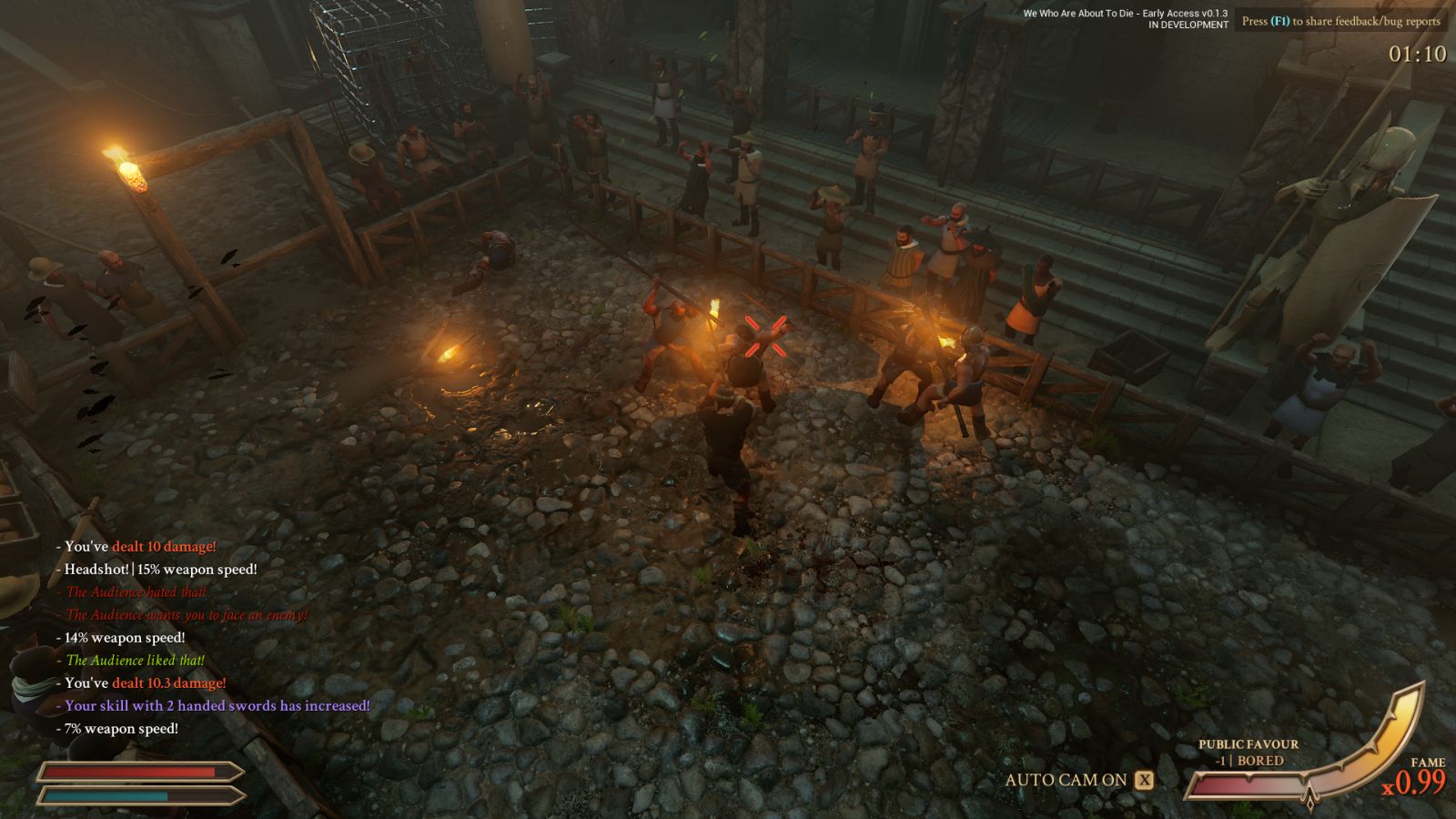
On top of pleasing the patrons, you also have to appease the bloodthirsty peasants who chuck equipment down into the arena (or tomatoes if they dislike you). Their affinity to you can be seen on a meter on the lower right corner of your screen. Sometimes they want you to change weapons mid-fight. They asked me to use a two-handed club, but why would I do that when I’ve spent the last ten matches leveling up my one-handed sword skill and learning my sword’s range? Sure, sometimes you have to improvise when a sword breaks mid-fight, but trying to batter a late-game enemy to death with a wooden pole that some peasant chucked at my feet is out of the question.
The public favour meter goes against the rest of the game’s philosophy of playing slow and smart. In a steam discussion about camera angles Jordy said, “…the goal was always slow methodical combat with tactics, not high-paced action where you spam inputs.” I was in a massive team fight, dodging, kiting, planning carefully, but the audience doesn’t want that, they want BLOOD. You have to walk a tightrope, juggling, playing carefully, managing stamina, and appeasing the crowd, as their approval is tied to how much fame you gain. Imagine if Devil May Cry had a stamina system tied to its stylish system. It feels dissonant. Am I supposed to play fast and stylish to appease the rating system or am I supposed to take my time and pace out fights like the developer says in the tutorial notes and constantly emphasizes? The system isn’t overbearing, but it still doesn’t mesh with the rest of the game.
Overall, We Who Are About To Die’s offers players a challenging, unique, indie rogue-lite with immense potential. For the most part, the systems tie into each other well, making the choices you make feel impactful, and combat feels satisfying to master. While some of the gameplay design choices lack harmony with the rest of the game, they don’t ruin the experience. Taking into account the fact that the game is in a good state now, and the developer is hyper-vigilant about eradicating any and all bugs, I can confidently say that this is an early-access game you can feel safe throwing your money at. Especially for the cost of $21.99.
